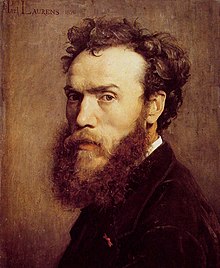Jean-Paul Laurens
Jean-Paul Laurens (born March 28, 1838 in Fourquevaux , Haute-Garonne department , † March 23, 1921 in Paris ) was a French painter , etcher and sculptor as well as draftsman and illustrator .
Life
Laurens first attended the art school in Toulouse and then became a student of Léon Cogniet and Alexandre Bida in Paris . After he had already taken part in the major exhibitions of the Paris Salon several times , in 1879 his picture “The Liberation of the Immured People of Carcassonne” was awarded a medal of honor.
Laurens taught at the École des Beaux-Arts and the Académie Julian in Paris.
reception
Laurens dedicated himself to history painting and since 1864 created a large number of boldly composed and energetically characterized paintings, which mostly deal with tragic, sometimes horrific scenes from history and are kept in a serious, often too dark and heavy tone. In order to produce the strongest effects, he sometimes gets into exaggerations of expression and movement.
For the Panthéon Laurens created two scenes from the life of St. Genoveva ("the saint on the death bed" and "the tomb of St. Genoveva"). He also created some notable portraits and was able to illustrate some of the works of the writer Amédée Thierry .
Works (selection)
- The death of Cato
- The death of Tiberius
- Hamlet
- Christ and the Angel of Death
- A voice in the desert
- The execution of the Duke of Enghien (Museum in Alençon)
- Popes Formosus and Stephen VII , 1870
- The Bethesda pond (1873, Toulouse museum)
- The Saint Bruno , who rejects the presents Rogers of Calabria (1874, Notre Dame des Champs in the church)
- The death of St. Genoveva
- The Interdict (museum in Havre)
- Francis of Borgia at the coffin of Isabella of Portugal (1876)
- The excommunication of Robert the Pious (1875, Museum des Luxembourg)
- The Austrian General Staff at General Marceau's deathbed (1877)
- The Liberation of the Immured People of Carcassonne (1879)
- The interrogation (1881)
- The last moments of Emperor Maximilian (1882)
- The vengeance of Urban VI. (1886)
- The agitator of the Languedoc (1887)
literature
- Anne de Margerie (Ed.): Jean-Paul Laurens (1838-1921). Peintre d'histoire . Réunion des Musées Nationaux, Paris 1997, ISBN 2-7118-3597-9 .
- François de Vergnette: Jean-Paul Laurens (1838-1921). Peintre d'histoire . Dissertation Sorbonne, Paris 2000.
Web links
| personal data | |
|---|---|
| SURNAME | Laurens, Jean-Paul |
| BRIEF DESCRIPTION | French painter, etcher and sculptor, as well as draftsman and illustrator |
| DATE OF BIRTH | March 28, 1838 |
| PLACE OF BIRTH | Fourquevaux |
| DATE OF DEATH | March 23, 1921 |
| Place of death | Paris |


